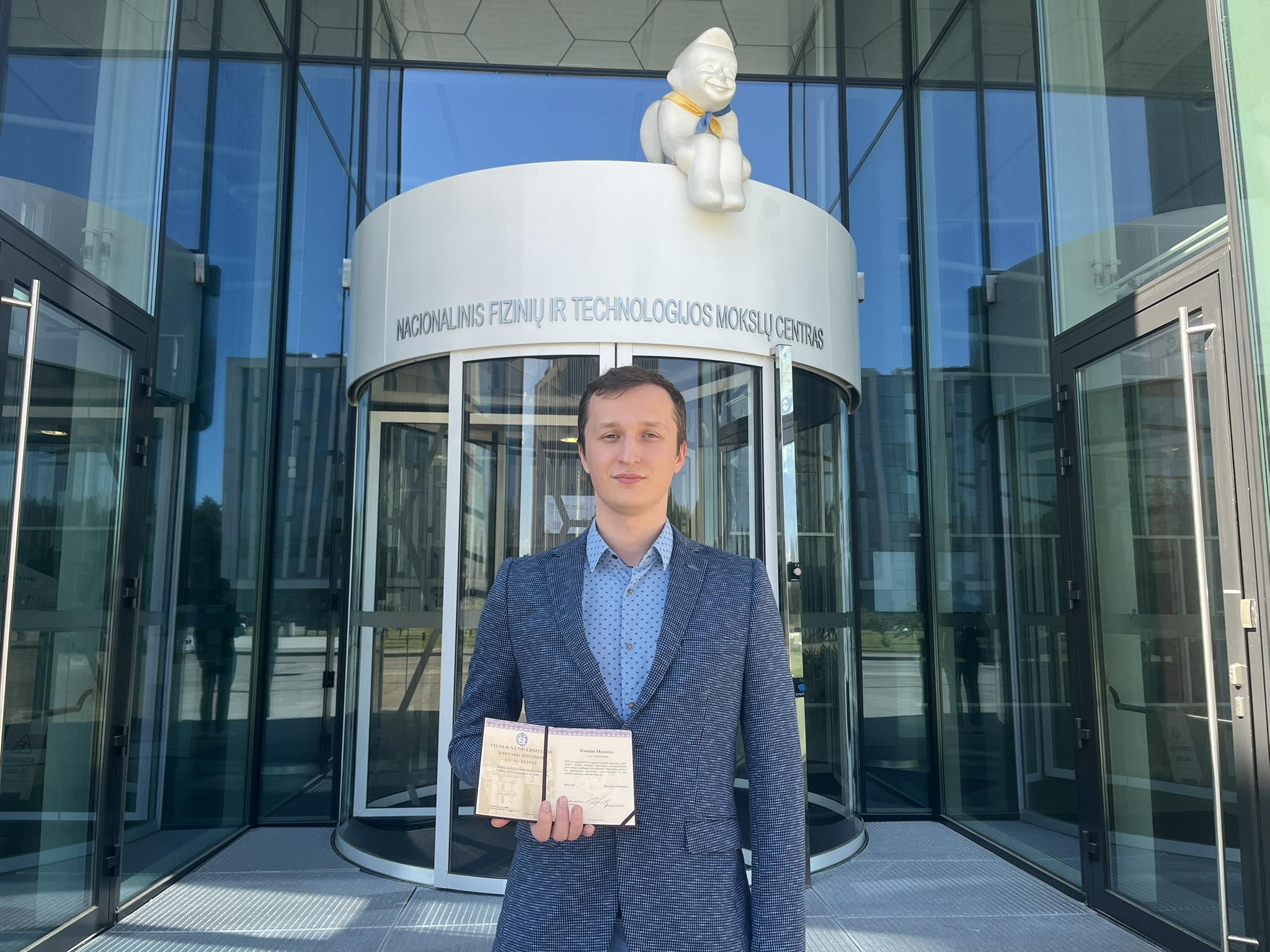Jakov Braver
"Topological Phenomena In Driven Quantum Gases"
The thesis explores manifestations of topological phenomena in systems of driven quantum gases. The first part of the thesis studies Floquet-engineered phases, namely the time-space crystalline structures, elucidating the role of time in systems with synthetic dimensions. The concept of topological particle pumping in the temporal dimension is developed, and a realisation of a topologically nontrivial eight-dimensional quantum system is proposed, with an emphasis on the relation to the quantum Hall effect. Additionally, a perturbative theory of calculation of quasienergy spectra in the case of resonant periodic driving is worked out in the extended Floquet–Hilbert space. The second part of the thesis investigates topological defects in Bose–Einstein condensates subject to a continuous optical perturbation. An optical scheme for creation of unconventional, strongly localised vortices in a two-component condensate is presented, and their properties are studied. The localised vortex present in one of the components is treated as an impurity and is used to probe the superfluid nature of the condensate.
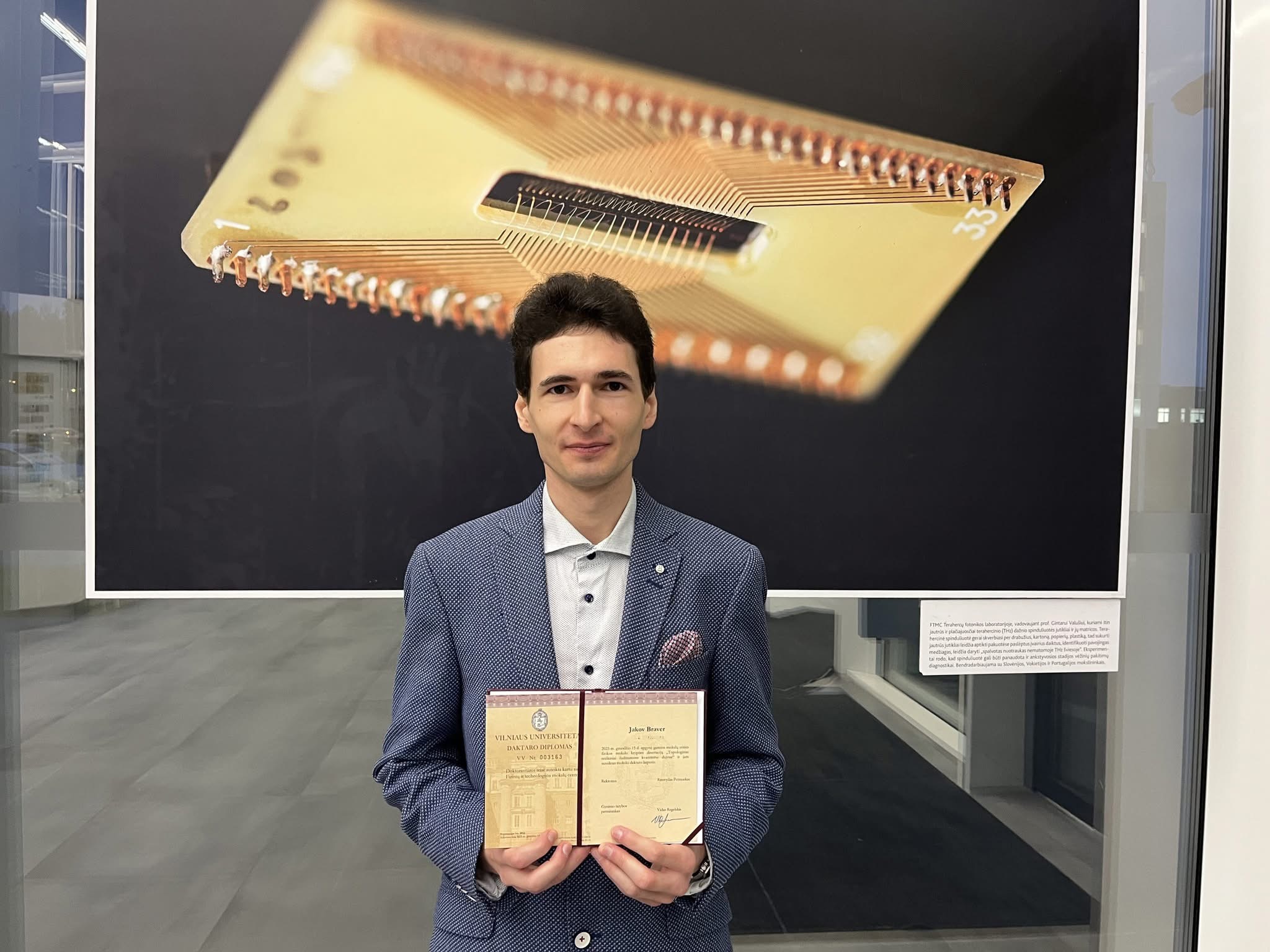
Vytautas Bubilaitis
"Spectral characteristic of molecular aggregates at various intensities of optical fields"
Molecular aggregates are versatile systems showing unique electronic excitations and excited state dynamics. Functionally, they are employed by Nature in photosynthetic light harvesting and energy funneling. In specific conditions, the aggregates are formed from synthetic dye molecules thus making a unique playground for design and studies of various quantum phenomena depending on the nature and the number of coupled chromophores. To understand, predict and control their optical properties in various spectroscopy experiments, theory and simulations must be developed and coordinated.
In this thesis, the highly nonlinear effects in nonlinear absorption, pump-probe and 3rd-5th order 2DES spectra of chromophoric aggregates are considered. Spectra are calculated by utilizing nonlinear exciton equations with exciton-exciton annihilation terms for various optical field intensities. We describe how the inclusion of exciton-exciton annihilation terms into nonlinear exciton equations affects the 2D electronic spectra at various levels of wave-mixing. Also compare several factorization types for nonlinear exciton equations for a linear chromophore aggregate from low to high excitation field intensities by calculating the simplest possible absorption spectrum. And study, by calculating pump-probe spectra, the behavior of nonlinear exciton equations solutions with exciton-exciton annihilation terms for J aggregate when restricting the calculations to subsets of excitons.
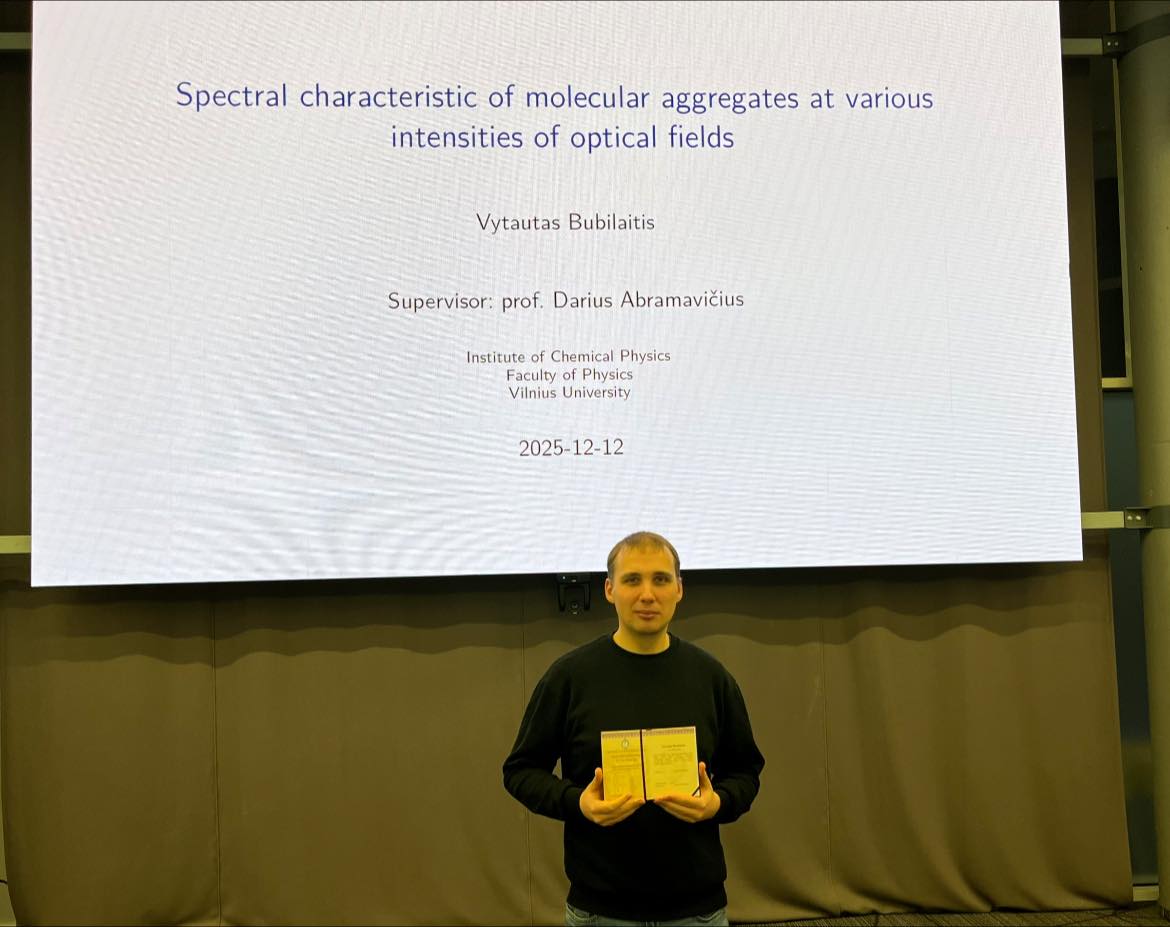
Jonas Banys
"Investigation of Optical Parametric Light Sources Pumped by the Subnanosecond Microlaser Pulses"
Optical parametric generation converts laser light into new wavelengths through the nonlinear interaction of intense laser pulses in specially engineered crystals. This thesis explores such phenomena in the sub-nanosecond pulse regime, developing and studying compact, wavelength-tunable parametric light sources pumped by modern Q-switched Nd:YAG microlasers. The research focuses on co- and counter-propagating three-wave interactions in periodically poled crystals. Developed optical parametric generators (OPGs) based on multigrating and fan-out MgO:PPLN crystals achieved wavelength tuning from 1.4 to 4.4 µm with up to 45% conversion efficiency, while also revealing device limitations imposed by optical damage and non-collinear interactions. Seeding these parametric systems with a narrowband diode laser and a fiber-generated supercontinuum significantly enhanced the output's energy, spectral, and stability characteristics. A green-pumped MgO:PPLN OPG revealed the complex interplay between parametric gain and nonlinear absorption, while off-axis pumping exploited the grating edge effect to tailor the OPG output properties. This OPG was used to seed a parametric amplifier, generating visible-tunable pulses. The first microlaser-pumped backward-wave optical parametric oscillators (BWOPOs) were demonstrated, generating counter-propagating signal and idler waves that delivered tunable sub-nanosecond pulses with pm-level bandwidth, high beam quality, and 50% conversion efficiency. Finally, parametric light generation was employed as a diagnostic tool to assess the homogeneity and thermal stability of the QPM crystals, offering valuable feedback for optimizing ferroelectric domain-engineered nonlinear media.

Vaida Marčiulionytė
"Supercontinuum Generation in Transparent Dielectrics at High Laser Repetition Rates"
Supercontinuum generation is a well-established and widely used technique for the production of a coherent, extremely broadband optical spectrum which is equivalent to a white-light laser. This dissertation aims at identifying the most suitable bulk solid-state materials that provide low supercontinuum generation threshold, efficient spectral broadening and robust long-term performance at high repetition rates with the state-of-the-art high average power ultrafast Yb:KGW lasers. In this work, reliable long-term operation at high pulse repetition rates was achieved in nonlinear materials with bandgaps below ~6 eV, exhibiting high nonlinearity and, consequently, low thresholds for supercontinuum generation. First demonstration of stable octave-spanning, low-threshold supercontinuum in bulk KGW crystal pumped by a 76 MHz Yb:KGW oscillator was achieved. It was also shown that, spectral broadening of femtosecond laser pulses in highly nonlinear bulk materials offers a promising alternative to fiber-based approaches, providing an all-solid-state setup for post-compression of low-energy (∼200 nJ) pulses at high repetition rates. Finally, it was revealed that the supercontinuum generation threshold rises for the second and subsequent pulses in a burst, increasing further with intra-burst repetition rate, thus imposing a practical limitation on burst-mode supercontinuum generation in solid-state materials. This work identified new efficient nonlinear bulk materials and revealed practical aspects for optimizing high repetition rate supercontinuum generation schemes, with potential direct applicability to high average power wavelength-tunable light sources, and ultrafast spectroscopy and imaging systems.
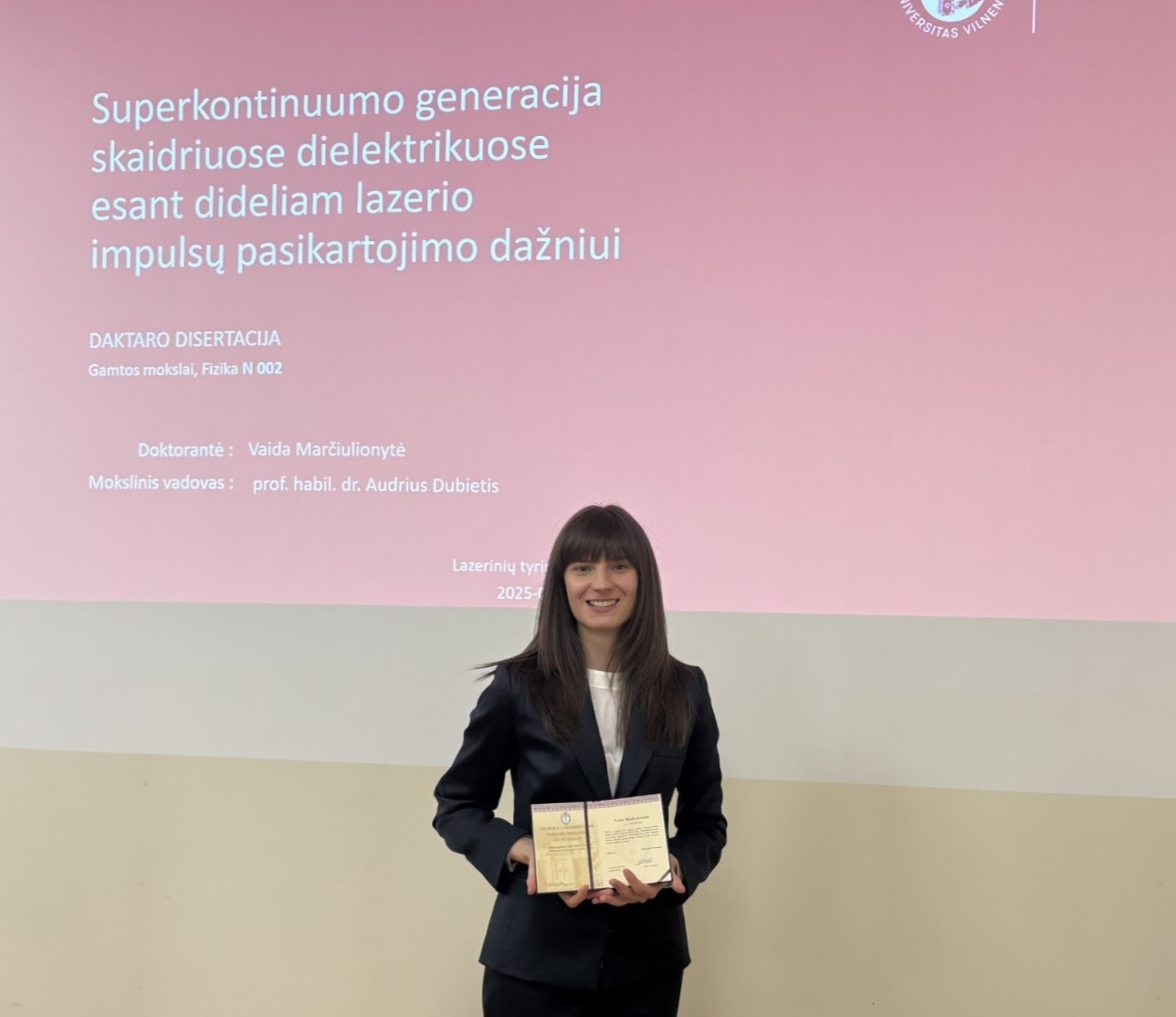
Erikas Atkočaitis
"Fatigue Effect in Optical Coatings: Parametric Study of Laser Irradiation Conditions, Temporal Scaling, and Lifetime Analysis"
This dissertation investigates the mechanisms of laser-induced damage (color change and catastrophic modes) and the corresponding laser-induced damage threshold (LIDT) in optical coatings across pulse durations from a few femtoseconds to continuous-wave. Particular focus is placed on thin metallic and dielectric coatings deposited on glass substrates. In dielectric coatings, experimental studies combine LIDT measurements with fatigue characterization and temporal absorptance analysis, enabling identification of scaling laws that govern damage evolution on realistic timescales. The results demonstrate that the LIDT of color change damage follows distinct scaling behavior, and its fatigue and absorption analysis allow the establishment of an absorbed dose threshold as the governing criterion for long-term optical degradation. For metallic coatings, LIDT scaling with pulse duration is shown to be controlled by heat dissipation within the coating and substrate. Comparative assessment of predictive models reveals that classical descriptions overestimate temporal absorptance dependence, while refined models incorporating intermediate defect states yield improved agreement with experimental data. The findings provide new insights into color change fatigue mechanisms, introduce a phenomenological predictive model for the optical lifetime of dielectric coatings, and deliver practical guidelines for the design of durable coatings for ultrafast and high-average-power laser applications.
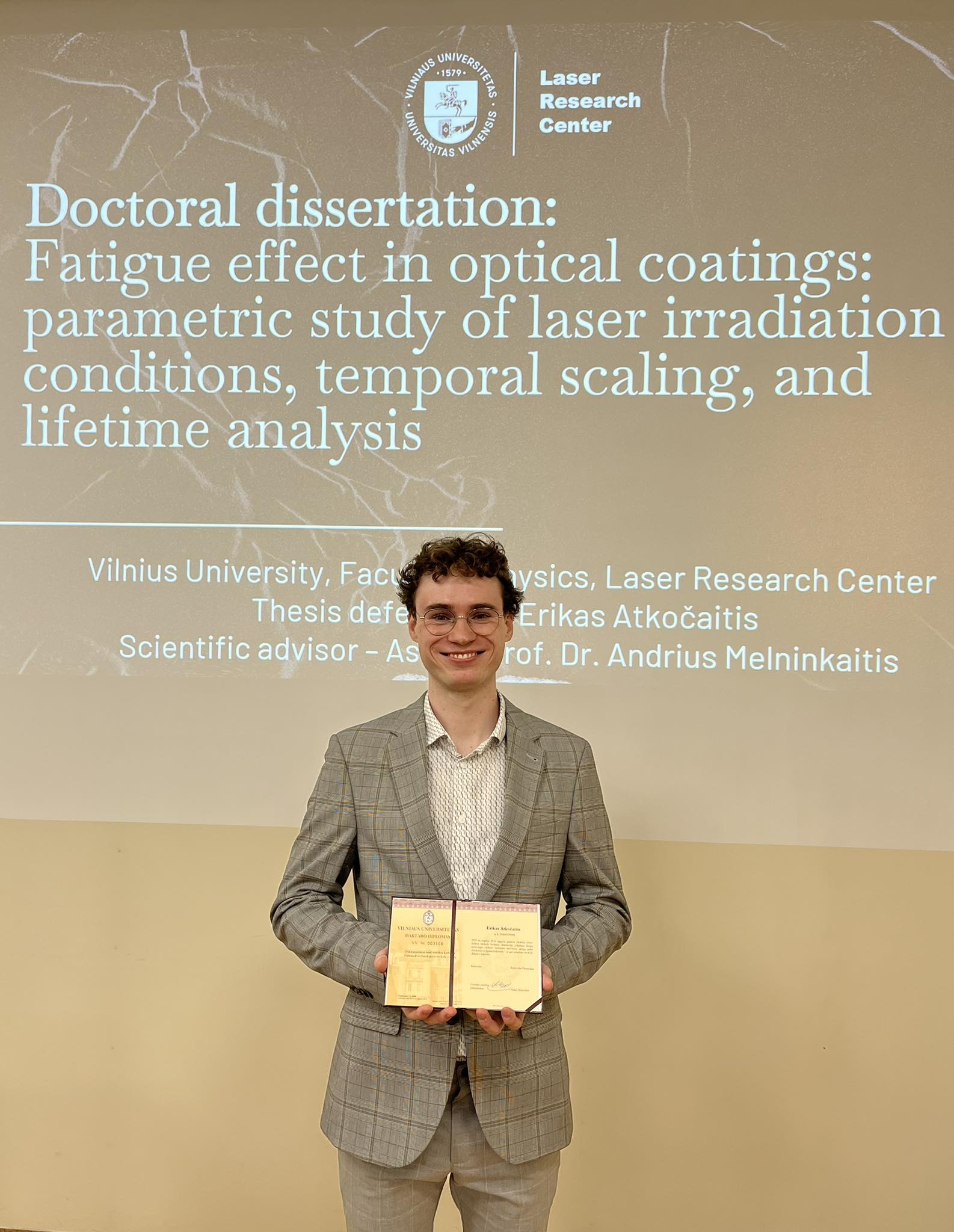
Romualdas Jonas Čepas
"Studies of charge carrier recombination and transport in disordered materials and their application in optoelectronic devices"
The focus of this dissertation encompasses several research areas within the development of organic solar cells (OSC), ranging from charge transport and recombination processes and their characterization methods to blend morphology and its stabilization. It addresses the enhancement of established methods for analyzing charge carrier recombination in OSCs, particularly aiming to establish the dependency of recombination rates on charge carrier concentration and the influence of processing additives. Additionally, this work delves into the development of cross-linkable hole-transporting materials, which are designed to serve dual roles: as insulating layers for the active layer and as matrices for donor-acceptor blends, thereby helping to prevent morphological degradation over time. Furthermore, the thesis investigates novel fluorene-core bipolar charge-transporting materials, which can exhibit balanced hole and electron mobilities. These materials hold potential for use in organic photovoltaic devices, donor-acceptor blends to enhance overall device performance by optimizing charge transport.
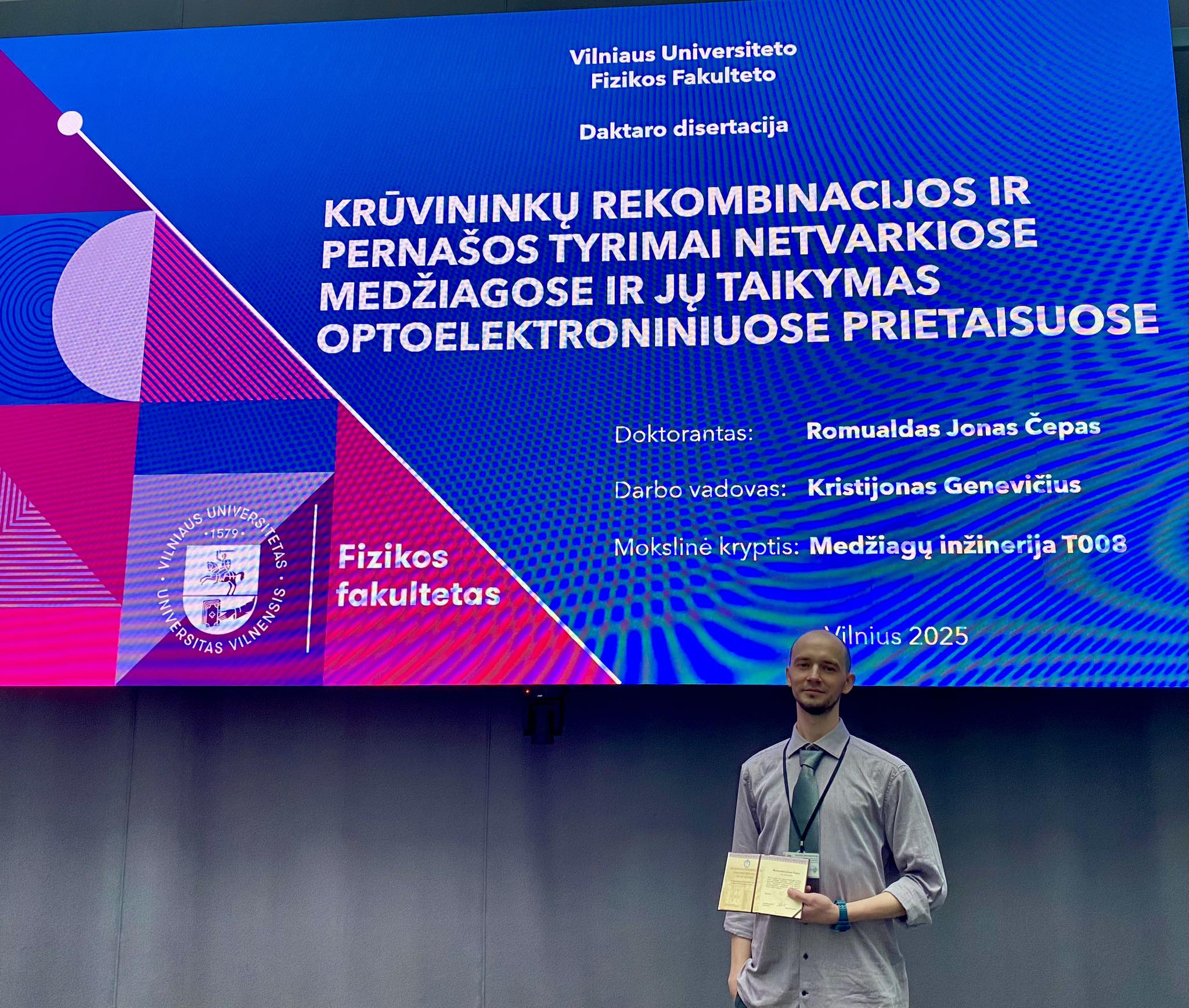
Žygimantas Vosylius
"Characterization and Mitigation of Mismatch Effects in Solar Cell Testing Using Advanced LED-based Solar Simulators"
Each year, hundreds of gigawatts of new solar power capacity are installed worldwide. One of the key challenges facing the solar cell and module industry is ensuring highly accurate characterisation of solar cell properties. These measurements must be carried out continuously in laboratory settings, even in the absence of stable natural sunlight. To achieve this, so-called solar simulators are developed using available artificial light sources.
This dissertation presents the development and evaluation of advanced LED-based and hybrid solar simulators that meet at least AAA-class requirements, while minimising the number of light source types used. It explores the effects of spectral mismatch across various types of solar cells and proposes strategies to mitigate these effects. The proposed mitigation approach, validated through comprehensive simulations involving different c-Si cell configurations, offers valuable insights for a complete and efficient transition to LED-based solar simulators, in line with evolving industry standards.
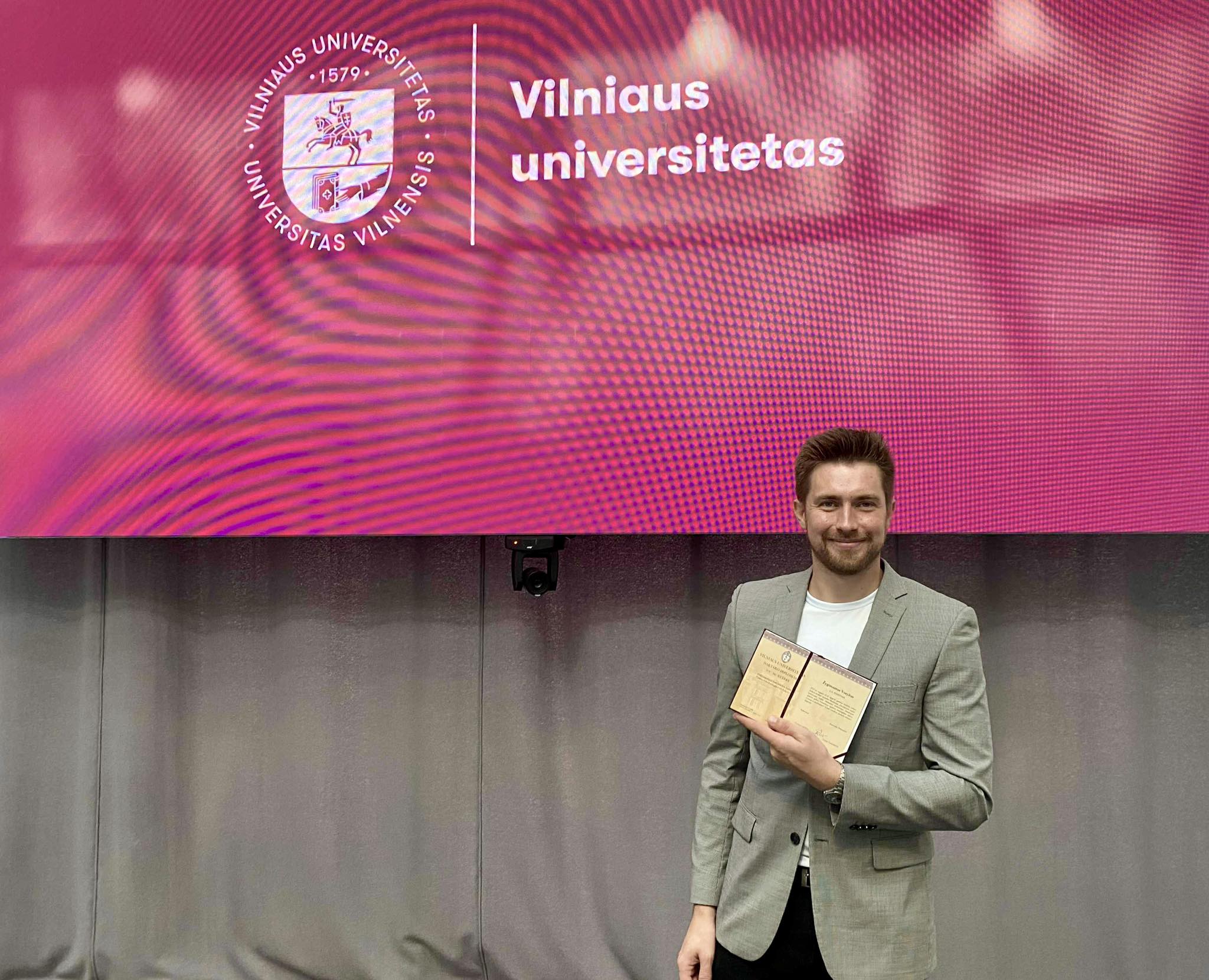
Miglė Kuliešaitė
“Investigation of nonlinear coherent phenomena in photonic crystal fibers”
Photonic crystal fibers (PCFs) open up new opportunities for the study of nonlinear phenomena, thanks to the ability to control their waveguiding properties – such as dispersion, nonlinearity, birefringence, and single-mode operation – during the manufacturing process. In this doctoral dissertation, the dynamics of coherent nonlinear phenomena occurring in PCFs are investigated and new methods are presented for characterizing the fiber’s nonlinear properties and the behavior of ultrashort optical pulses.
In this dissertation supercontinuum generation in a highly nonlinear polarization-maintaining PCF is first discussed, where controlled bursts of two orthogonally polarized femtosecond pulses are used for pumping. Then, an investigation of UV-VIS light generation in a short PCF is presented.
To better understand the nonlinear phenomena occurring in PCFs, it is important to have reliable methods for characterizing both the nonlinear medium and the pulses propagating through it. Therefore, this dissertation presents a new method for measuring the nonlinear refractive index of a polarization-maintaining PCF, based on measurements of the polarization state variation of the light exiting the fiber as the average power of the pump pulses is varied: the first method for determining the nonlinear refractive index of an already manufactured PCF. Finally, a non-iterative semi-analytical algorithm is presented, which enables reliable reconstruction of the intensity profile and phase of the investigated pulse from cross-correlation frequency-resolved optical gating (XFROG) measurements.

Dominyka Stonytė
“Ultrashort UV Pulse-Material Interaction for Laser Microfabrication Applications”
The rapid advancement in solid-state femtosecond laser system development and constant increase in output power have opened the path for laser processing while using femtosecond pulses in the deep-UV spectral range. While ultrashort pulses offer highly temporally confined energy deposition, short wavelength ensures high spatial localization leading to precise shallow material modifications.
This dissertation investigates the interaction of ultrashort deep-UV laser pulses with high bandgap dielectrics, such as crystalline sapphire, silicate glasses, barium fluoride. It explains the underlying mechanisms of material removal and analyzes the outcomes while using different parameters, such as pulse overlap, fluence, number of pulses, wavelength. It was demonstrated for the first time that the ablation quality of c-cut sapphire can be significantly increased (surface roughness reduced up to 7 times, heat-affected zones eliminated) when using deep-UV instead of IR pulses. Additionally, the first successful experimental demonstration of femtosecond deep-UV pulse application in multi-level diffractive optical element fabrication is shown. Furthermore, diffractive photon sieves having the smallest focal length of 9 mm were presented and characterized in this work. Consequently, the successful fabrication of a binary axicon on Barium Fluoride is presented. The fabricated element was used to extend the depth of the field in the IR imaging of silk samples at the Australian Synchrotron facility.
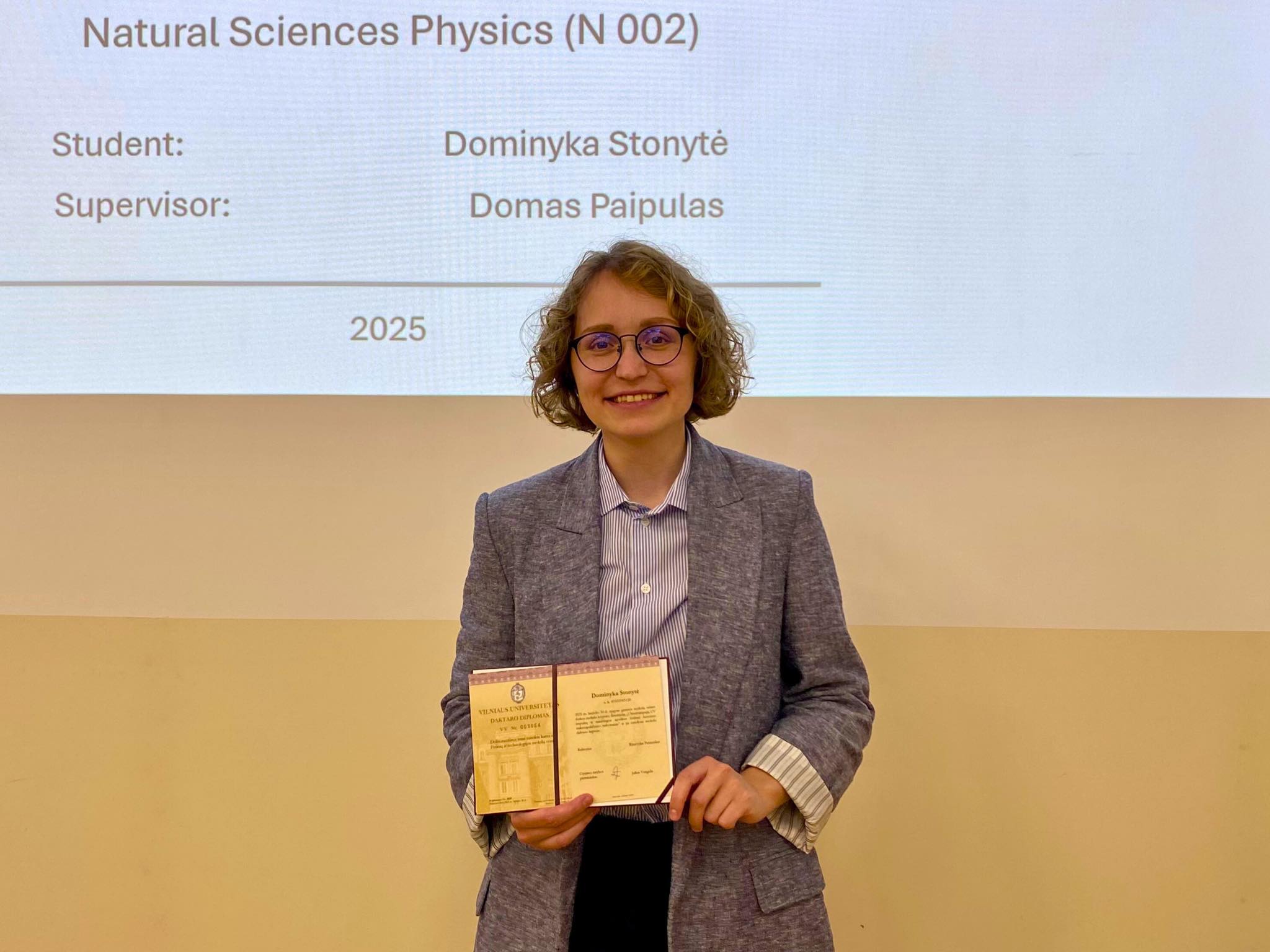
Vadzim Haronin
“Pulsed Laser Deposition and Broadband Dielectric Spectroscopy of Complex Perovskite Materials”
This dissertation explores the applications of the pulsed laser deposition (PLD) method and broadband dielectric spectroscopy to study thin films and bulk materials of some complex perovskite materials such as PbZr₀.₂Ti₀.₈O₃, 0.8(Na₀.₅Bi₀.₅TiO₃)-0.2(BaTiO₃), ZrSnSe₃, Nb-doped and undoped BiFeO₃–BaTiO₃ (BF–BT), and PbHf₀.₉₂Sn₀.₀₈O₃ (PHS) crystal. The dissertation analyzes how different PLD parameters (such as fluence, deposition temperature, ambient pressure, etc.) affect the quality and structure of thin films. Broadband dielectric spectroscopy reveals the dynamics of phase transitions and the dielectric response of different ferroelectric materials at various temperatures. The obtained results show that in BF–BT ceramics, the relaxor-type dielectric dispersion dominates, with frequency-dependent permittivity peaks and thermally induced transitions between ordered and disordered states. In PbHf₀.₉₂Sn₀.₀₈O₃ crystals, the dielectric dispersion maximum shifts towards higher frequencies (to the GHz range) as it approaches the Curie temperature. A very high residual polarization (93 μC/cm²) was obtained in the PbZr₀.₂Ti₀.₈O₃ thin layer, exceeding even the value of the bulk material, which is due to the stresses that have arisen between the layer and the substrate.